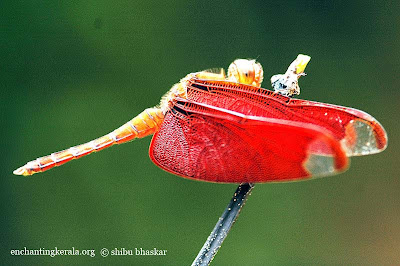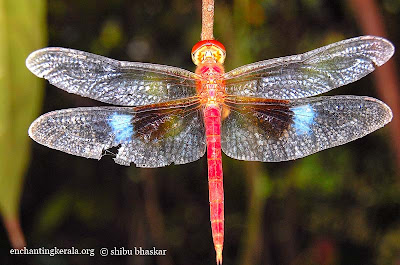Dragonflies and damselflies are amongst the prominent and colourful insects in tropical landscapes. Dragonflies and damselflies collectively called odonates, are one of the most common insects flying over forest, fields, meadows, ponds and rivers. About 6,000 extant species are distributed all over the world. India is highly diverse with more than 500 known species.
Some Interesting Facts
- Odonata are one of the ancient orders of insects.
- Dragonflies and mayflies were the first to develop wings and venture into air.
- Dragonflies first appeared during the Carboniferous era, about 250 million years ago along with mayflies (Ephemeroptera).
- Meganeuropsis americana from Carboniferous era had a wingspan of 71 cm, almost the span of pigeon.
1. Choose the right equipment for the job
For photographing dragonflies and damselflies you may use a compact digital camera with macro or a DSLR preferably with a 105mm or 200 mm lens with macro.
 |
| agriocenimis keralensis dragonfly |
2. Knowledge about Dragonflies and Damselflies
Most of the dragonflies and damselflies can be observed at very close range. They are very specific about breeding habitat. Male dragonflies are mostly territorial especially those of Scarlet marsh hawk, Crimson marsh glider and parakeet darner. But some species like Common picture wing, Wandering glider, Pied paddy field skimmer and Ditch jewel are more tolerant. Generally in most species males are more attractive than females.
Dragonflies and Damselflies are more tolerant to human presence near them than butterflies. Even if they fly away when you make your approach if you stay still for some time they will recognize you and realize that you are no threat to them and will come pretty close to you allowing you enough time to compose your shot. They are also very curious creatures. If you happen to be near them you could observe that they are actually watching you in between their activities.
 |
| othetrum dragonfly |
3. When to watch
Best time for Photographing Dragonflies and Damselflies is during Mornings and Midday
Best time to watch odonates is during midday. They are most active during this time. Some species are crepuscular or nocturnal. It is very difficult to locate and observe them in low light conditions.Many odonate species are seasonal and their emergence and breeding coincide with the monsoon. So most of odonate species can be observed between May-November.
Best time to watch odonates is during midday. They are most active during this time. Some species are crepuscular or nocturnal. It is very difficult to locate and observe them in low light conditions.Many odonate species are seasonal and their emergence and breeding coincide with the monsoon. So most of odonate species can be observed between May-November.
 |
| blue grass dart dragonfly |
4. Habitat - Where to watch Dragonflies and Damselflies
Odonates are found in a diverse habitat. However, their diversity and abundance vary with the habitat. Best place to see various odonate species and their behaviour is near freshwater bodies such as ponds, tanks, streams and rivers where there is good sunlight.
 |
| Scarlet marsh hawk dragonfly |
5. Always wear Mute Colour Dresses
Due to their sensitive eye, odonates get easily disturbed with bright coloured objects. So it is better to wear dull coloured clothing and cap, while photographing.
 |
| Dragonfly photography |
6. Slow and Careful Approach
Approach your dragonfly slowly, if it gets disturbed or flies off just get into position and freeze they will come back to the same spot.
 |
| common picture wing dragonfly |
Unlike butterflies dragonflies sit still on twigs and branches that protrude out of the water for long periods of time so you get ample time to arrange your gear, focus and shoot. So always use a tripod and try to get images with the lowest ISO setting.
 |
| stream glory dragonfly |
8. Correct the White Balance of the Camera to get genuine Colours
Dragonflies and Damselflies are very colourful creatures. Their wings and body is composed of hundreds of shades of different colours. In order to capture the genuine colours of the subject you should always correct the white balance of your camera before you start shooting. Choose the correct mode as per lighting conditions like, cloudy, shade or daylight etc and check to see that they render correct colours before you make your approach.
 |
| fulvous forest skimmer dragonfly |
9. Use of Flash Enhances Dragonflies photos
Quite often than not its found that using flash tends to light up and bring to life the various shades of shining colours in the dragonflies wings and body. So Try taking some shots with the flash on.
 |
| othetrum dragonfly |
10. Focus on the Eye or Thorax
Try to get your focus right on the eye or thorax of the dragonfly. If the eye is not in focus then the shot looses its appeal as its the most prominent part of the subject that attracts attention of the viewer.
11. Preferred Aperture is 8 or 11
A minimum aperture setting of 8 is necessary to get all parts of the dragonfly or damselfly in focus but if you go beyond 11 it will be very difficult to isolate the subject and throw the background out of focus. A background that is also in focus is very distracting when we are shooting a subject as small as a dragonfly or a damselfly.
 |
| stream ruby female dragonfly |
12. Shutter speed is not Important
Dragonflies and damselflies tend to sit still for long periods so while photographing dragonflies and damselflies shutter speed is not important unless you are trying to take a picture of them in flight, hovering, mating or feeding.
 |
| urothemis signata dragonfly |
13. Use Some Reflectors
Whenever possible use some reflectors to reflect some light especially on the wings and thorax of the dragonfly or damselfly it helps to bring the details of their magnificent wings and body.
14. Use Centre Point Focus
Set the focus of your camera to centre point focus as its easy to attain focus on the right areas of the subject.
 |
| fulvous forest skimmer dragonfly |
15. Use Single Focus or Focus Manually
Use single focus never use continuous focus. Best method is to use single focus get your camera to focus on the eye of the dragonfly or damselfly hold the shutter release halfway locking the focus and frame your shot and shoot. If you use continuous focus the camera tends to shift focus as you try to frame your shot resulting in out of focus pictures.
 |
| Photographing dragonflies |
16. Use Centre Weighted Average Metering Mode
Select the centre weighted average metering mode of your camera to bring about even lighting in your image and to ensure that there is enough light on the subject. If you use centre spot metering the pictures tend to get over exposed and if you use average metering the pictures tend to get under exposed.
 |
| black marsh dart dragonfly |
17. Choose the right angle to shoot - Place Subject on the Plane of Focus
Since you will want all parts of the dragonfly of damselfly in focus like the wings and the body, try to position your camera parallel to the wings of the dragonfly thereby ensuring most of your subject are in one geometrical plane ensuring that they are all in sharp focus.
 |
| coral tailed cloud wing dragonfly |
18. Choose the right background by moving the Angle / Position
Be careful while framing your shot dragonfly has very thin wings that are rich in many shades of colours if lit up well but if the background is cluttered or fussy the image will never stand out. So try to get the background right by either adjusting your angle or by shifting your position isolating the dragonfly by getting water / sky as background produces stunning results.
In the next article we will discuss about Photography - Nature and Wildlife Photography - Nature Photography -10 Tips to shoot Amazing Nature Photographs
Post a Comment